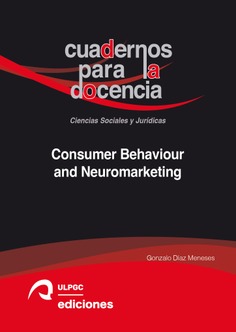
Consumer Behaviour and Neuromarketing
Gonzalo Díaz Meneses (Escritor)
The primary concern of this book is to help guide Master's students seeking insight into consumer behaviour. It is an educational tool devised for those participating in advanced marketing classes that makes use of empathy maps, buyer persona templates, perceptual maps and customer journey modelling. It has no other ambition but to assist in discussions and interactions. It should trigger self-reasoning, fuel decision-making based on rigorously designed thought techniques and encourage postgraduate students to play an active role when preparing for their classes and revising for exams, paving the path for them to become highly qualified marketers.
- Escritor
- Gonzalo Díaz Meneses
- Colección
- CUADERNOS PARA LA DOCENCIA: CIENCIAS SOCIALES Y JURÍDICAS.
- Materia
- Ventas y marketing
- Idioma
- English
- EAN
- 9788490424872
- ISBN
- 978-84-9042-487-2
- Depósito legal
- GC 326-2023
- Páginas
- 244
- Ancho
- 24 cm
- Alto
- 17 cm
- Edición
- 1
- Fecha publicación
- 03-07-2023
- Número en la colección
- 9
Contenidos
INTRODUCTION
CHAPTER 1: Preliminary notions
1.1. The definition of marketing
1.2. The definition and multidisciplinary background of consumer behaviour
1.3. Discussion on the ethics of marketing
1.4. Gaining insight into the colloquial versus academic use of marketing
1.5. Linguistic reasons for the mistrust about marketing
1.6. Translating and interpreting marketing
1.7. The marketing approaches
1.8. The marketing theory from a pragmatic and practitioner perspective
1.9. The digital marketing contribution
The questions to test your knowledge
Bibliography
CHAPTER 2: Modelling consumer behaviour
2.1. The definition of modelling and its variables
2.2. Types of models
2.3. The customer journey and the conversion funnel
2.4. How to model
2.5. Examples of modelling
The questions to test your knowledge
Bibliography
CHAPTER 3: Neuromarketing
3.1. Definition of neuromarketing
3.2. The neuromarketing research techniques
3.2.1. The selfreport techniques
3.2.2. The biometric techniques
3.2.3. Neurometrical techniques
3.3. The brain functioning
3.3.1. The brain parts and the nervous systems
3.3.2. Neurochemical functions
3.4. Ethical concerns
The questions to test your knowledge
Bibliography
CHAPTER 4: Targeting
4.1. Definition and conditions of the target market and targeting
4.1.1. The requirement of delimiting the audience
4.1.1.1. The requirement of understanding the customers
4.1.1.2. The requirement of viability
4.2. Describing the target audience and the targeting task: key questions and instrumental notions
4.3. Phases and steps entailed in the targeting procedure
4.4. The preliminary phase and step 0
4.4.1. General questions
4.4.2. Functional questions
4.4.3. Personal questions
4.5. Design thinking tools to perform targeting
4.5.1. How to design an empathy map
4.5.2. How to elaborate a conceptual map to understand consumer volition
4.5.3. How to build a table to profile the consumers
4.6. Market and neurosciences research techniques
4.7. How to gain insight into the empathy map and the conceptual maps
4.7.1. How to tap the insights from the empathy map
4.7.2. How to tap the insights from the conceptual map
4.8. Practical implications
4.8.1. Relationship marketing
4.8.2. Guerrilla marketing
4.8.3. Benchmarking
4.8.4. Promotional marketing
4.9. Example of targeting
4.9.1. The description of the Ferrero Rocher company
4.9.2. The empathy map of the Ferrero Rocher company
4.9.3. The conceptual map of the Ferrero Rocher company
4.9.4. Practical implications derived from the conceptual map of the Ferrero Rocher company
4.9.5. Sociodemographic and situational characteristics of Ferreros customers
4.9.6. Practical implications derived from the sociodemographic and situational characteristics of Ferreros customers
4.9.7. Nestle: the Ferrero Rocher competitor
4.9.8. The Nestle conceptual map to target their customers
4.9.9. Practical implications derived from the Nestle conceptual map
4.9.10. Sociodemographic and situational characteristics of Nestles customers
4.9.11. Practical implications derived from the sociodemographic and situational characteristics of Nestles customers
4.9.12 The conceptual map to understand the potential market
4.9.13. The practical implications derived from the conceptual map to understand the potential market
4.9.14. The sociodemographic and situational profile of the potential market
4.9.15. The managerial implications stemming from the sociodemographic and situational profile of the potential market
Exercises of targeting
Bibliography
CHAPTER 5: Positioning
5.1. What is positioning?
5.2. The goals of positioning
5.3. Analysing brand positioning
5.3.1. The product attributes
5.3.2. The service attributes
5.3.3. The personal attributes
5.3.4. The image attributes
5.3.5. Point of parity versus difference
5.3.6. The Brandz equity model
5.4. The positioning drawbacks
5.5. The perceptual map tool, several research techniques and the steps to take
5.6. Repositioning strategies and practical implications
5.7. Giving an example of positioning for Mercedes, Audi and BMW
5.7.1. What is the brands evocation set of Mercedes target market?
5.7.2. What are the most relevant and comparable dimensions to consider?
5.7.3. Research design
5.7.4. The conceptual map
5.7.5. The repositioning objectives
5.7.6. Repositioning strategies
Exercises
Bibliography
CHAPTER 6: Segmentation
6.1. Definitions
6.2. The segmentations requirements
6.3. The segmentation criteria
6.4. The segmentation strategies
6.5. The segmentation research techniques
6.6. How to carry out a segmentation
6.6.1. Find ground for the segmentation by giving the answer to several questions and performing different tasks
6.6.2. Describe the segmentation
6.6.3. What strategy to implement
6.7. Giving an example of segmentation with buyer personas
Exercises to practise
Bibliography
CHAPTER 7: Crosscultural
7.1. Definition of culture
7.2. Associated concepts
7.3. Describing the cross cultural techniques
7.4. Describing how to perform a cross cultural analysis
7.5. Giving an example of cross cultural analysis
7.5.1. The research project rationale
7.5.2. Gathering and collating relevant data
7.5.3. Data analysis techniques
7.5.4. The restaurant cross-cultural dining guest journey with practical implications
Exercises
Bibliography





